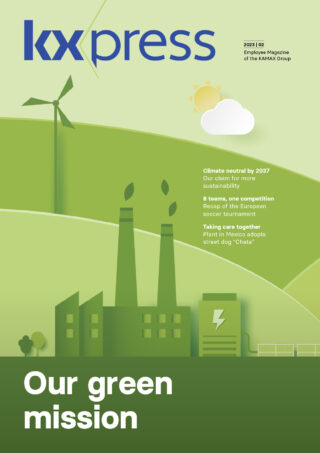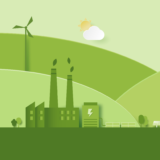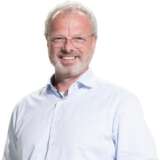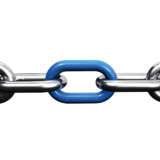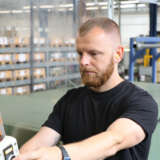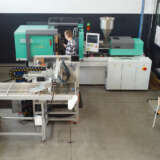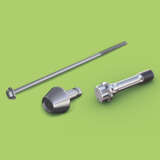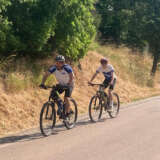The first steps
2037 is the year from which we want to stop emitting CO₂. The previous two pages show why this is necessary. But what are we already doing to achieve this? The start has been made, and we have determined the size of our carbon footprint. At the same time, teams at all our sites are looking for solutions to reduce it. One thing is clear: It’s certainly not easy, and our efforts are currently limited. The path will require a lot of perseverance, bold ideas, and unconventional solutions and big invests. Nevertheless, we have already taken some first steps. Take a look at them!
Solar energy on factory roofs
Our new Jintan (China) plant has been planned sustainably from the beginning. One of the most important components: the solar panel system on the roof of the production facility. A relevant part of the energy consumed is to be generated by this. At the same time, many other plants are looking into installing solar panel systems on the roofs of their buildings. (So it may well be that in a few years, significantly more KAMAX plants will be using the sun to generate clean energy.) We can significantly increase the global share of self-generated clean energy and are currently investigating the most economically sensible approach towards green energy for the KAMAX group.
Using heat from production
In both Germany and China, we have started to recycle the exhaust heat generated in our production. In Homberg (Germany), the team installed a ventilation system with heat recovery in Hall 13. In Wujin (China), waste heat is used for drying waste oil sludge and for the plant’s air conditioning system. Previously, the parts were simply cooled down from 900°C to below 100°C in the cooling oil tank, but now the heat is extracted and turned into an additional energy source and we are not even close to using the full potential globally.
New lighting
Over the past few years and years, we have upgraded the lighting in several of our plants, such as Museros in Spain, Lapeer in the USA, Wujin in China, and Turnov in the Czech Republic. These updates have covered a significant area of several thousand square meters. Our new lighting fixtures use energy-efficient LED lights, which have replaced halogen lamps in most cases. As a result, we have observed a noticeable reduction in power consumption.
Green energy for customer projects
Some automotive customers already require that certain products be produced only with green power from solar, wind, or bioenergy. So far, we supply our plants with a mix of energy from different sources. We now certify that only green electricity is used there for specific customer products. In the long term, we will switch completely to these renewable energies for all products.
Electricity meters for employees
To raise awareness of the need to save electricity at home and work, the Turnov (Czech Republic) plant distributed electricity meters to all employees around Christmas. These are attached to the power socket. An app on the cell phone makes it possible to track and reduce electricity consumption daily. In this way, we can raise awareness for electricity consumption and saving ressources.
Less scrap
Our waste and scrap generates more than 30,000 metric tons of CO₂ emissions each year (8 percent of our total emissions). So less waste and scrap helps us improve our sustainability footprint. Our team in Lapeer (USA) has succeeded in reducing their production scrap by 1%. The result: 450 less tons of steel scrap and more than 20 truck trips eliminated. There are also steady improvements and progress in recycling materials and waste at the other plants.
Environmental management at all sites
All KAMAX operations and our subsidiary 4fastening have environmental management systems certified to ISO 14001. This means we must know and assess our environmental impact, develop goals and programs to improve environmental performance, meet legal obligations, train employees, create emergency plans, and record and communicate these efforts. The standard also requires regular reviews and internal audits to ensure the system is working effectively.
Small steps with a big impact
A big change also includes smaller measures that, when taken together, make a difference. The site in Bardejov (Slovakia) shows how it’s done: cycling to work is encouraged. Just recently, we built a shelter for bikes at the plant site. That’s not all. To prevent water waste, the team has installed economical faucets and shower heads and controls lights with motion sensors, so they only shine where they are needed. In the office, employees reduce their screen brightness, which saves up to 25% of the energy consumed.
KXpress
